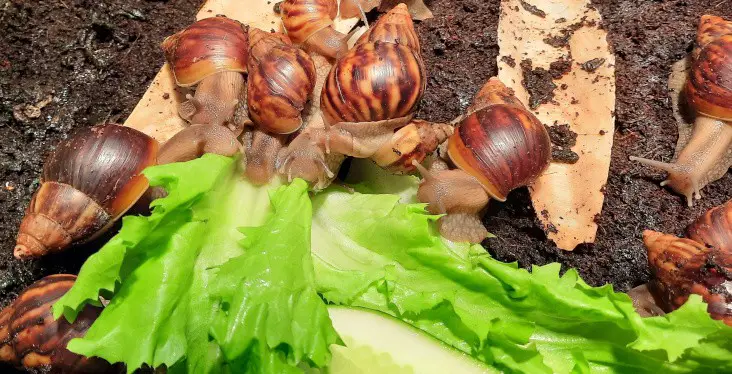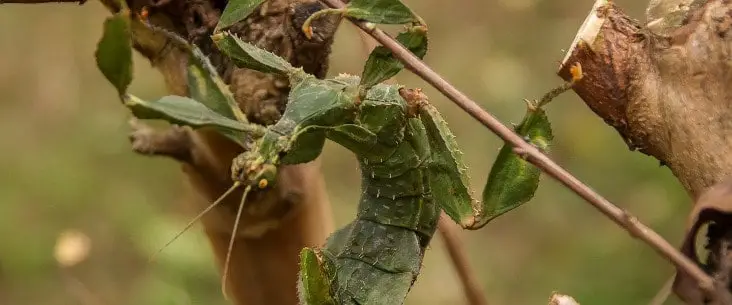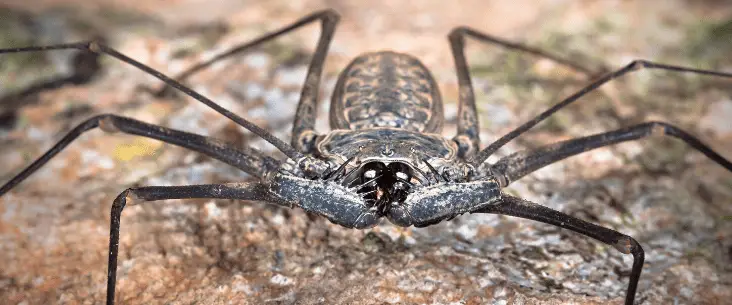The exotic pet bugs industry is growing every year and more and more people keep these lovely pets. They are amazing, easy to keep and take care of. But although they are truly amazing, you still need to make good consideration before you start keeping them. They are quite different from keeping cats, dogs, birds, or other commonly kept pets.
If you have always been interested in keeping exotic pet bugs and you considering buying your own pet bug, there are a few things that you have to ask yourself before you buy one and jump right in keeping them. Although pet bugs are one of the best pets you can have and pretty easy to care for, you should know exactly the responsibilities that are part of it.
Below I have compiled a complete list of important questions that you should ask yourself before buying any exotic pet bug such as cockroaches, stick insects, tarantulas, millipedes or praying mantises.
#1 Do I understand the needs of the animal?
Keeping exotic bug pets is quite different from more commonly kept pets. Dogs, horses and birds, for example, have a need for a social companion. Is it not you then it is a buddy they live with. Bugs, on the other hand, often don’t care much about social companions (although there are exceptions of course).
Exotic bugs have more need for optimal enclosure design and ambient environment which differs from our own room environment. Many exotic bugs species need a warmer and more humid climate, so you need to heat the enclosure and spray water in it to keep it moist.
The enclosure — terrariums, aquariums or customized plastic containers — need to fulfil in size and in features (like ventilation capacity) to fit with the needs of your bug animal.
Do the necessary research to clearly understand the needs of the animal you like to buy.
#2 Do I have the necessary experience to care for my exotic animal?
Investing in the correct materials to house and keep exotic bugs is one thing. Taking care of them is something totally different.
You must understand how to take control of your terrarium — or another type of enclosure — so that the temperature stays optimal and keep the environment clean.
And what about feeding your animal. With millipedes and beetles, it is quite easy. But feeding tarantulas is quite another skill. And did you know that with stick insects you must have a good understanding of plant species and quality?
You have to read and learn about how to care for your exotic animal. That means you need to read guides about the species and discuss experiences on forums and breeders. Don’t worry. If you are serious about keeping a certain exotic animal, the experience will come soon enough but start with a species that is more beginners friendly.
#3 Do I have the time for my new pet?
Many new keepers choose these types of exotic animals because they take much less time. To some extent this is true: they take much less time to care for in comparison with dogs, bunnies or horses. However, they still need some time to give the proper care. Especially periodic larger cleaning sessions take some time.
So make sure you have the time needed to provide the care they need. A part of the care is close observation of the behaviour to understand how your animal is feeling. This is, for example, very true for tarantulas and scorpions.
Stick insects need plants collected from your neighbourhood. Finding the correct plants that are fresh and free of pesticides and pest animals can take definitely some time, especially in the beginning. So be sure to have at least 3 hours every week of free time to care for your pet animal. Still, this is less than commonly kept pets.
#4 Do I have the right space to keep them?
Exotic pets generally need much less space than other pets. The golden rule is to provide for ground-living animals three times the body length in surface space and two times the body length in height. So, that means a single millipede with an adult size of 10cm needs an enclosure of at least 30cm by 30cm and 20cm high.
With species that needs height, it is the other way around. There it is normally three times the adult body length in height and two times the adult body length in width. So, a stick insect that reaches 10cm in body length needs an enclosure with a 20cm x 20cm surface and 30cm of height.
However, it is not only the size of the enclosure. It is also about the location of the animal. None of the exotic bugs species should be placed in direct sunlight. Vibrations of hard noises (music, television, other hobbies) and running children should be avoided too. So first determine that you have the right space for the animal to house properly.

#5 Do I mind that these animals generally don’t liked to be petted?
Although several species of exotic bugs can be handled and touched, doesn’t mean they like it. Generally speaking, these animals don’t like to be petted. They do better when you leave them alone and only observe their interesting and amazing behaviours in your living room display.
If you want to handle your pet, like letting giant snails or millipedes walk on your hand, that is totally fine. But be careful when you do. These animals are fragile and when falling from your hand can damage them.
Some animals are able to fly. Stick insects and praying mantises (often the males) may be quite good at it. So when you take them out of your enclosure, keep the windows closed so they won’t escape if they choose to fly away.
Related read: What Bugs Make Great Pets For Kids: The 7 Coolest Pets
#6 Do I accept the longevity of the animal?
Generally, exotic bugs don’t have a long lifespan. The short longevity can be seen as a benefit if you want to try out if a certain species suits you or your kid. It is also amazing to see all the life stages of an insect or bug. However, keep in mind that some animals may live for a pretty long time.
Tarantulas, for example, can live up to 30 years in captivity. And an ant colony can also grow and sustain for as long as the queen lives, which is around 15 years. So with some exotic bugs, it is a long commitment for the care for the animal.
However, short-living animals such as stick insects or beetles have challenges on their own. Without the proper care and breeding attempt, the fun is over within 1,5 years. So if you like to enjoy it for longer, you have to learn about breeding the species.
But you may ask why not buying a new animal again? Well, not all animals are available all the time and it can become more costly. Besides that, it is very interesting to breed with these extraordinary animals. There is much to learn about their way of life and survival.
#7 Do I have a plan when they breed (exponentially)?
We talked about breeding exotic bugs. You should be aware that (some) exotic bugs can reproduce exponentially and at such a pace you soon have too many animals to house properly.
Some stick insects like the Indian stick insect is a good example of this. Many people offer the eggs for free purely because they don’t know what to do with them anymore. Sun beetles can also reproduce rather quickly.
So you have to make a plan when you have too much offspring. Learn about breeding restrictions (such as destroying eggs or feeding your offspring to other animals) with your species or think about how to sell them. If you don’t like that idea, choose a species that is not likely to breed quickly or only keep a single-sex group.
#8 Am I okay with feeding live food?
Be ready that some exotic bugs only eat live food. So you have to get used to handling live insects like crickets, cockroaches and locusts. Tarantulas and praying mantis only eat live food and won’t do it with dead feeder insects.
That also means that you need to keep and store feeder insects in your house and care for them as well. Think of feeding (gut-loading) them, and sometimes clean the feeder insect enclosure.
You can buy feeder insects rather easy at larger pet shops or feeder insect breeders online. But you can also breed them yourself to have a self-sustaining supply of good nutritious feeder insects.
If you don’t like live feeder insects, choose a species that lives from plant material: beetles, millipedes, snails and stick insects.
#9 Can I find a holiday-keeper for my new exotic pets?
Every pet animal is a commitment. It is no different with dogs as with beetles. But, what about holidays. If it is a short one it probably won’t be a problem. Many species can live perfectly fine weeks without food. Tarantulas can easily survive one to two weeks without feeding them. Scorpions can even be fine with 3 to 4 weeks without food.
But many other bugs need food regularly if not daily. So you have to plan who will care for your pet animals. And although you are fine with keeping such animals (and have the experience to do so), try to find one that can take over the care when you are on holiday can be difficult. Not all people like the idea to care for such animals.
And you can’t take such animals with you on holiday like you can with a dog. Their special climate and care are not suitable to take on a trip with you. So think about who’s gonna take care of your animals when you are not around.

#10 Do I accept that some pet bugs can escape, survive and breed outside the enclosure?
We don’t like insects infesting our house. Roaches crawling in your kitchen, ants walking in a line to any sweetness, fruit flies infesting your house.
When keeping exotic bugs, be aware that when they escape (and some are quite good at it), they may survive outside their enclosure in your house. Okay, that would not be such a problem at first, until they start to breed.
Be sure to understand that certain species can become a pest in your own house and that you willingly take a risk to keep such animals.
Don’t be afraid, however, because there are many species that first won’t escape that easy and secondly won’t survive/thrive outside their enclosure. Especially when you live in a region with winters. Stick insects, praying mantises, and tarantulas are bugs that can easily be kept without worrying that it becomes a problem.
One thing to keep in mind though is that feeder insects are typically known to breed very rapidly. Think of crickets or dubia roaches. So keep in mind that, although you have bugs that won’t become a problem, their food can be a problem.
#11 Do I mind that my animal can harm me?
Now let me make myself clear first: there is no bug you can keep as a pet that has the ability to heavily harm you or kill you. Maybe the only example is some species of old-world tarantulas (but without the proper experience I wouldn’t recommend them anyway).
But some animals can mildly harm or irritate you. Let me explain. Tarantulas have certain defence mechanisms such as a bite or flicking irritating hairs at you. Now, the hairs are pretty annoying, but a bite is rather painful (can be compared with a sting of a large bee).
Centipedes can also sting you and the sting is, just like tarantulas, mildly venomous but quite painful. Millipedes can secrete a foul-smelling substance that can irritate the skin and some ants have quite a painful bite (like the one from leaf-cutter ants / Atta spp.).
Now, all that I described above are defence mechanisms often used when they feel threatened or when you keep them without the proper knowledge and experience. So although an animal can inflict such harm, it doesn’t mean they do or when you keep them properly can do.
But if you don’t like the idea that your animal has the potential to do you any harm, you should choose a species that lacks such defence mechanisms. Most beetles and stick insects are harmless and make perfect pets as well.
Now, there is one thing to be aware of, and that is that you can be allergic to (certain) bugs. A cockroach allergy, for example, is a well-reported allergy. Especially when you have asthma, there is a chance that you have an allergy or can develop an allergy from a certain species of bug.
#12 Do I mind that my animal can make (annoying) sounds?
This is often an overlooked one: sounds. Especially annoying sounds. If you can be annoyed by a leaking tap, then you probably be also annoyed by the falling of stick insect eggs on the terrarium floor.
Many bugs are silent from themselves but can make annoying sounds with certain behaviour. Crickets and locusts are good examples in this case. They can make sounds almost continuously and it can make you completely mad. There is no off switch on them. So do sun beetles frequently fly clumsy around in their enclosure, making a pretty loud buzzing sound.
But it is not only the animals that can make annoying sounds. Heating pads, heating lamps, mechanical time switches, or aquarium pumps can also make annoying sounds but can’t turn off — well they can but — because they regulate the climate of your animal.
However, ant colonies, praying mantises, millipedes and tarantulas are animals that are (almost) completely silent. It is just something to think about when you want to buy an exotic animal.
#13 Is it legal to keep these exotic pets in my country?
Maybe I should have mentioned it earlier. Not all exotic pets are legal in every country. In the United States are quite some regulations regarding the keeping of exotic pets. Where some species is not a problem to keep as a pet, others are strictly prohibited and you can get heavy fines when keeping them.
Other countries can have other regulations. It is your own responsibility to check your local authority if a certain species can be kept as a pet. When a certain animal is offered by a local shop/breeder doesn’t mean it is legal to keep. Always check before you buy.
Some animals can only be kept with a certain exemption and proof of origin. But your local authority can tell you all about it.
#14 Does my landlord accept keeping these animals?
Although it is legal to keep the species in your country if you rent a property the landlord must also accept that you keep such animals. Sometimes it is written in the agreements if and which animals you can keep or cannot keep.
However, I can recommend you to be open about it and always ask if it is accepted that you keep certain exotic bugs. If you have a good conversation about it, maybe there is more possible than what you earlier expected.

#15 Is there anything else I need to know?
Know that you have asked yourself these questions, you start your search for the animal that suits you best. I can’t say enough that proper research on the species at forehand is very important so that your expectations match the reality. You don’t come up with surprises then.
I can advise you to ask all the questions you can come up with on the seller themself as well. His or her experience can be vital for your research. It gives you an even better idea of what it is to keep that certain animal. Don’t make an impulsive purchase when it comes to a live animal. Choose your pet animal wisely to have the most joy out of it, to keep your animal happy, and you won’t be disappointed.
Bugs you can keep as a pet
If you have made good consideration about the questions above, take a look at the many bugs that make great pets below to learn more about them and what it takes to keep them as a pet.
– Phasmids (stick insects and leaf insects)
– Praying mantises
– Millipedes
– Beetles
– Ant colony
– Tarantulas
– Giant snails
Share this page!



